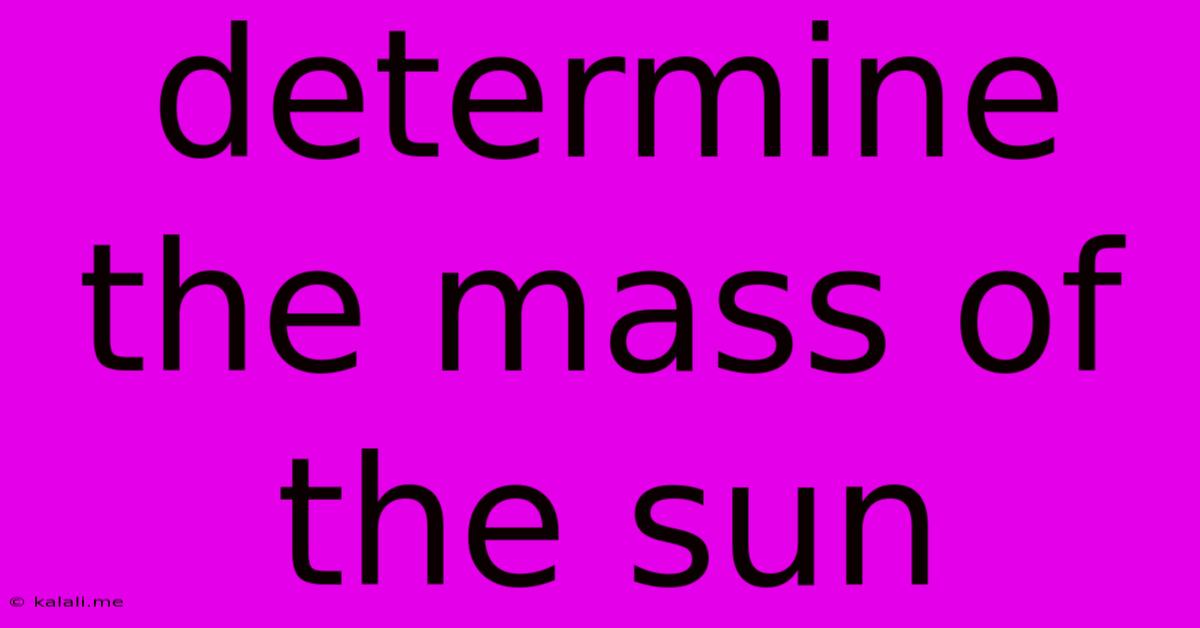Determine The Mass Of The Sun
Kalali
May 09, 2025 · 3 min read

Table of Contents
Determining the Mass of the Sun: A Celestial Weigh-In
Determining the mass of the Sun, a seemingly impossible task, is actually achievable through clever application of physics and observation. This article delves into the methods used to calculate this fundamental cosmological constant, explaining the concepts in an accessible way. Understanding the Sun's mass is crucial for comprehending our solar system's dynamics, the formation of stars, and the universe's overall structure.
Understanding the Gravitational Dance: Newton's Law of Universal Gravitation
The key to determining the Sun's mass lies in Newton's Law of Universal Gravitation. This law states that every particle attracts every other particle in the universe with a force proportional to the product of their masses and inversely proportional to the square of the distance between their centers. Mathematically, this is expressed as:
F = G * (m1 * m2) / r²
Where:
- F is the gravitational force
- G is the gravitational constant (a known value)
- m1 and m2 are the masses of the two objects
- r is the distance between their centers
By observing the orbital motion of planets around the Sun, we can use this law to deduce the Sun's mass.
Using Planetary Orbits to Calculate Solar Mass
The most straightforward method involves analyzing the orbit of a planet, such as Earth. We know the Earth's orbital period (one year), its average distance from the Sun (one astronomical unit, AU), and we know the value of G. By applying Newton's Law of Universal Gravitation and Kepler's Third Law of Planetary Motion (which relates orbital period and orbital radius), we can solve for the Sun's mass (m1).
Kepler's Third Law provides a simplified relationship:
T² ∝ r³
Where:
- T is the orbital period
- r is the average orbital radius
Combining Kepler's Third Law with Newton's Law of Universal Gravitation, and accounting for the appropriate constants, allows for a relatively simple calculation of the Sun's mass. The calculation yields a value remarkably close to the currently accepted value.
Refining the Calculation: Accounting for Perturbations and Refinements
The above method provides a good approximation. However, several factors need consideration for more precise calculations:
- Perturbations from other planets: The gravitational influence of other planets slightly affects the orbit of any single planet, introducing minor inaccuracies. Advanced calculations account for these gravitational perturbations.
- Relativistic effects: At high speeds and strong gravitational fields, Einstein's theory of General Relativity provides a more accurate description of gravity than Newton's Law. These relativistic corrections are necessary for extremely precise measurements.
- Improved measurements of astronomical constants: More precise measurements of the gravitational constant (G) and astronomical units (AU) lead to more accurate calculations of the Sun's mass.
Modern techniques involve sophisticated computer models that simulate the complex gravitational interactions within the solar system, producing extremely accurate estimations of the Sun's mass.
The Result: A Massive Star
Through these methods, scientists have determined that the Sun's mass is approximately 1.989 × 10³⁰ kilograms. This is a colossal amount, representing the vast majority of the mass in our solar system. This knowledge is foundational for understanding stellar evolution, planetary formation, and the broader context of our place within the cosmos. Further research continues to refine this figure, pushing the boundaries of our understanding of the universe.
Latest Posts
Latest Posts
-
How Was The Modern Periodic Table Arranged
May 09, 2025
-
What Is Half A Mile In Feet
May 09, 2025
-
17 6 As A Mixed Number
May 09, 2025
-
What Percent Of 75 Is 3
May 09, 2025
-
69 Out Of 80 As A Percentage
May 09, 2025
Related Post
Thank you for visiting our website which covers about Determine The Mass Of The Sun . We hope the information provided has been useful to you. Feel free to contact us if you have any questions or need further assistance. See you next time and don't miss to bookmark.